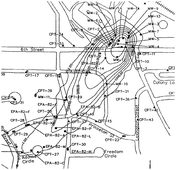Subsequent to modeling of natural attenuation processes to predict contaminant trends and plume dynamics, monitoring data were used to evaluate the effectiveness of natural attenuation at reducing contaminant concentrations in groundwater at seven fuel-contaminated sites. Predicted and observed contaminant trends at seven sites were compared in order to empirically assess the accuracy of some fundamental model input parameters and assumptions. Most of the models developed for the study sites tended to overestimate plume migration distance, source persistence, and/or the time required for the benzene, toluene, ethyl benzene, and xylenes (BTEX) plumes to attenuate. Discrepancies between observed and predicted contaminant trends and plume behavior suggested that the influence of natural attenuation process may not have been accurately simulated. The conservatism of model simulations may be attributed to underestimation of natural source weathering rates, overestimation of the mass of contaminant present in the source area, and/or use of overly conservative first-order solute decay rates.

You have access to this article
 Please wait while we load your content...
Something went wrong. Try again?
Please wait while we load your content...
Something went wrong. Try again?


 Please wait while we load your content...
Please wait while we load your content...